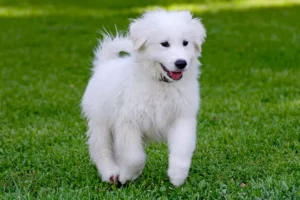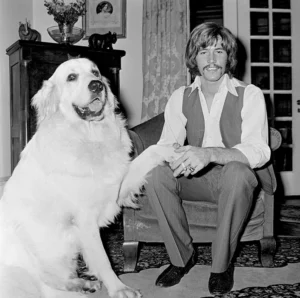Great Pyrenees
Great Pyrenees are serious, intelligent dogs that need plenty of room to roam around and are wonderful family companions. Find out more about residing with Pyrenees.
Great Pyrenees Overview
| OFFICIAL NAME | Great Pyrenees |
| COMMON NAME | Great Pyrenees |
| PET HEIGHT | 25 to 32 inches |
| PET WEIGHT | 85 to 100 pounds |
| LIFESPAN | 10 to 12 years |
| GOOD WITH | cats, children, dogs, families, seniors |
| TEMPERAMENT | aloof, gentle, protective, willful |
| INTELLIGENCE | high |
| SHEDDING AMOUNT | frequent |
| EXERCISE NEEDS | medium |
| ENERGY LEVEL | calm |
| VOCAL LEVEL | frequent |
| DROOL AMOUNT | medium |
| BREED GROUP | working |
| BREED SIZE | large (61-100 lbs.) |
| COAT LENGTH | long |
| COLORS | white |
| PATTERNS | bicolor, spotted |
| OTHER TRAITS | cold weather tolerant, highly territorial, strong loyalty tendencies, tolerates being alone |
The distinctive features of Great Pyrenees include their flowing, long white coats and thoughtful faces. Large, powerful, placid, and intelligent dogs, affectionately called “Pyrs,” were bred in the Pyrenees mountains to protect sheep from strong predators. They have always been used to working hard and taking initiative. They’re not very common in the US, maybe because this breed isn’t for everyone. At times, they can be stubborn and difficult to teach, and then they can be sweet and obedient. On the other hand, the Great Pyrenees can make devoted family pets for the correct owner.
Appearance Great Pyrenees
No wonder the Great Pyrenees is frequently referred to a polar bear—given its size, remarkable strength, and thick, fluffy white coat. The shoulder height of a Great Pyrenees dog ranges from 25 to 32 inches. Males can weigh well over 100 pounds, while females typically average about 85 pounds. These dogs have soulful, intelligent eyes that are rich and brown in color.
“These are really pretty dogs,” remarks Haddonfield, New Jersey-based veterinarian Scott Neabore, DVM, owner of Neabore Veterinary Clinic. The Great Pyrenees are primarily white, but they can also have tan, gray, or badger patterns on them. Surprisingly, the second coat resists tangles and grime. Brushing helps control the flying fur because Great Pyrenees shed constantly.
Temperament Great Pyrenees
The Great Pyrenees have a calm, quiet, and collected demeanor since they were bred to keep an eye on sheep and cattle for extended periods of time. Neabore remarks, “The ones I see are fairly stoic.” “You may very much do as you please with them. Unlike some other breeds, they are not extremely theatrical.”
Their innate need for independence may manifest as aloofness or willfulness toward outsiders. Puppies of Great Pyreneeses should be socialized and trained when they are still young due to this predisposition and their size. All things considered, this breed is kind and devoted, and he makes an excellent family dog or guardian, keeping an eye on his owners, their kids, and other animals.
Living Needs Great Pyrenees
Great Pyrenees roots are mountain dog, and they crave cold weather. “These are the kind of dogs that, if it’s snowing out, they want to be outside and they don’t want to come inside,” Neabore explains. It’s true that you might not think of a breed like this if you reside in Florida. They will be more comfortable in the cooler temperature, not that you can’t have it.”
Given that Great Pyrenees puppies were meant to be outdoors, their natural environment would be a sizable, gated yard, or possibly a farm or ranch. Because of their propensity for roaming, these dogs also have an urge to explore and escape, therefore leashes and gates are essential—off-leash experiences are not recommended. The Great Pyreneese puppy prefers routine and quiet, and they have a tendency to bark. These dogs are nocturnal; they are more playful after dark and tend to sleep the day away because they were raised to stand guard over sheep at night. Pyrs get along well with other pets and are kind to cats and other smaller animals.
The Great Pyrenees: have historically been solitary regions. They can tolerate being by themselves these days, but they also have a propensity to become bored, which can result in bad actions.
“Your family is likely to experience behavioral problems if they don’t have much time for a dog, you work a lot, and the dog spends all of their time at home staring at the wall. They could have worry, separation anxiety, and other issues of that nature, according to Neabore. “These are canines in need of employment. To keep them from becoming totally bored, you want to play with them, take them on long walks, and engage in enrichment activities.”
Care Great Pyrenees
Because of their double coat, which keeps them warm in the winter, pyrs shed a lot. In addition to a more extensive shed in the spring, there is seasonal shedding. It helps if they brush their hair at least once a week. The grooming regimen should also include routine nail care and teeth brushing.
Given the active nature of the Great Pyrenees breed, moderate exercise, such as frequent walks, is beneficial to the dogs’ mental and physical well-being. They are great working dogs and take pleasure in hauling carts, obedience training, and trials.
The Great Pyrenees Club of America claims that in terms of training, pyrs can be strong-willed and intelligent. They may not perceive the need to sit when called upon and have been described as “almost cat-like in their independence.” When working with these dogs, consistency, patience, and positive reinforcement are essential.
Health Great Pyrenees
At 10–12 years old, the Great Pyrenees has a long lifespan for a large dog. Even though they are normally healthy, Great Pyrenees can develop a variety of illnesses, such as dysplasia of the elbow and hip, knee issues, eye disorders, neurological disorders, and some types of cancer.

Furthermore, this breed is susceptible to bloat, also known as gastric dilatation-volvulus (GDV) complex, a disorder in which the stomach twists due to an accumulation of air. It may endanger your life. According to Neabore, there appears to be a genetic component to bloat, despite certain preventative measures that owners can take.
He frequently suggests a technique called a gastropexy, which can be done when the animal is being spayed or neutered and involves suturing the stomach’s outer wall to the body wall to prevent it from migrating, to the owners of large-breed puppies, especially Great Pyrenees. Neabore describes the operation as “small.” “With any of those large, deep-chested breeds, I usually recommend doing that as a protective measure against having that problem down the road.”
Owners of Great Pyrenees should speak with their veterinarians about health risks and preventive options.
History Great Pyrenees
The hilly area between Spain and France, where these unusual white puppies originally defended sheep for their owners, inspired the name of the pups. Their heavy, waterproof coats protected them from the cold in the high heights.
These canines have always been revered for their intelligence and majestic appearance. The Great Pyrenees Club of America claims that the Great Pyrenees was so beloved in France that King Louis XIV’s court proclaimed the breed the “Royal Dog of France” in 1675.

According to fossil evidence, these dogs have existed since prehistoric times. This breed, considered to have originated as far back as 11,000 years ago in Asia, is similar to deposits found in the 1800–1000 B.C. Bronze Age.
There are several Great Pyrenees mixes, including Malanees (Great Pyrenees plus Alaskan malamute), Shepnees (Great Pyrenees plus German shepherd), Pyredoodles (Great Pyrenees plus poodle), and others. Currently, there is just one type of Great Pyrenees.
Fun Facts
- Queen Victoria of England was a proud owner of Great Pyrenees in the middle of the 19th century.
- The Great Pyrenees are known for having twin dewclaws, which are two toenails that protrude slightly above the feet on the inside of the back legs. Rarely seen in working dogs that historically need additional assistance to get across difficult terrain, especially mountains, this trait is unique.
- Different names for the Great Pyrenees exist in different nations. They go by the name of Pyrenean mountain dog in the United Kingdom. They are known as le chien des Pyrenees (the dog of the Pyrenees) or le grand chien de montagnes (the huge dog of the mountains) in France.
For More Information visit our Homepage:

